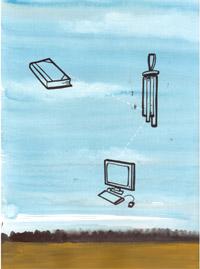Digital Humanities Profiles: Innovations in the Capital Region

Three institutions, located in or around our nation's capital, are leaders of innovation in the digital humanities. This post will highlight a few of their key contributions.
The University of Maryland at College Park is home to the Maryland Institute for Technology in the Humanities (MITH). Founded thirteen years ago under the directorship of Emily Dickenson scholar Martha Nell Smith, MITH was created to explore the engagement of humanities research with new media technologies, to encourage training in new technologies to a broad community, and to provide space and equipment in support of those goals (see their “About MITH” page captured by the Internet Archive in 2000).
One important area of innovation at MITH is born-digital preservation. “Librarians and archivists have not failed to take note as computer storage media, as well as entire computers, have begun arriving on their doorstep as an increasingly routine part of the acquisition of an author’s ‘papers’” writes MITH Associate Director Matthew Kirschenbaum; cultural heritage institutions are finding themselves the recipients of digital materials—often on old machines with obsolete software, which raises the important question of how these should be preserved and made accessible to researchers and the general public (Kirschenbaum et al. 2009, p. 3; see also Kirschenbaum et al. 2010).
MITH is host to several initiatives in this area, including conferences such as “Computer Forensics and Born Digital Content in Cultural Heritage Collections” (May 2010), and ongoing projects such as “MITH’s Vintage Computers.” And, next year, they will host a special institute on Digital Humanities Data Curation, sponsored by an NEH Advanced Topics in the Digital Humanities grant (see the NEH Office of the Digital Humanities website for more information about this grant). With these and many other efforts, MITH is a center of innovation in the digital humanities.
At George Mason University in Fairfax Virginia, another key institution is the Roy Rosenzweig Center for History and New Media (CHNM), named in honor of its late founder, “a pioneer in the field of digital history” (“Roy Rosenszweig Prize for Innovation in Digital History,” AHA.) Under the leadership of its current director Dan Cohen, CHNM is a leader in developing new tools for humanities research, including the scholarly research management utility Zotero and Omeka, a content management system “designed for scholars, museums, libraries, archives, and enthusiasts.” (See this THL post about Professor Cohen and his upcoming visit to Berkeley).
Inspired by the potential for the internet to “democratize history” and increase access to learning and education, Roy Rosenzweig worked to create CHNM as a “democratic, collaborate space” for research in areas related to digital history (chnm.gmu.edu/about/). His efforts were successful, as can be seen from CHNM’s wildly popular creation THATCamp (The Humanities and Technology Camp), a digital humanities meeting designed on the radically democratic ‘un-conference’ model, which eschews academic and corporate hierarchies and presenter/audience dichotomies in favor of open collaboration. Rosenzweig’s democratic vision is also apparent in the fact that both Zotero and Omeka are freely available under Creative Commons licenses. A proud monument to its founder’s ideals, the Roy Rosenzweig Center for History and New Media has contributed much to the advancement of the digital humanities.
In Charlottesville VA, The Institute for Advanced Technology in the Humanities (IATH) at the University of Virginia is another pioneering institution in the digital humanities (and, established in 1992, outdates the term ‘digital humanities’ by nearly a generation).
As can be seen from the earliest Internet Archive snapshot of the its website (see Software development at IATH in 1997), from the beginning, IATH has taken seriously the need to create research tools for the humanities. And, recognizing that this requires putting computer science and humanities researchers together, they envision their program as “a unique collaboration between humanities and computer science research faculty” (About IATH.) Their projects spanning a wide range of humanities research, from segregation and travel, to Dante, to the early Chinese “Traditions of Exemplary Women” [列女傳], IATH research fellows continue to explore the ways we can use computing for research in the humanities.
Home to MITH, CHNM, and IATH (and several other institutions as well), the Washington D.C. region is a center of digital humanities innovation. More than geographical proximity, these institutions share a successful approach to the digital humanities, one which emphasizes community, collaboration, and a hands-on engagement with computing technologies. This approach is predicated on humanities researchers getting their 'hands dirty' with the technologies themselves: in the spirit of the unofficial THATCamp motto attributed to Dave Lester, “less yack, more hack” (which, it should be added, is not meant to disparage theory, but to emphasize the necessity of actually using the technology). At each of these institutions, a deep engagement with computing has yielded great contributions to the advancement of the humanities.
Scott Paul McGinnis is pursuing a Ph.D. in History at UC Berkeley and is involved in several digital history and digital humanities initiatives. He joined the Townsend Center Blog team in September 2012.
Image Credit: Derrick Mosley